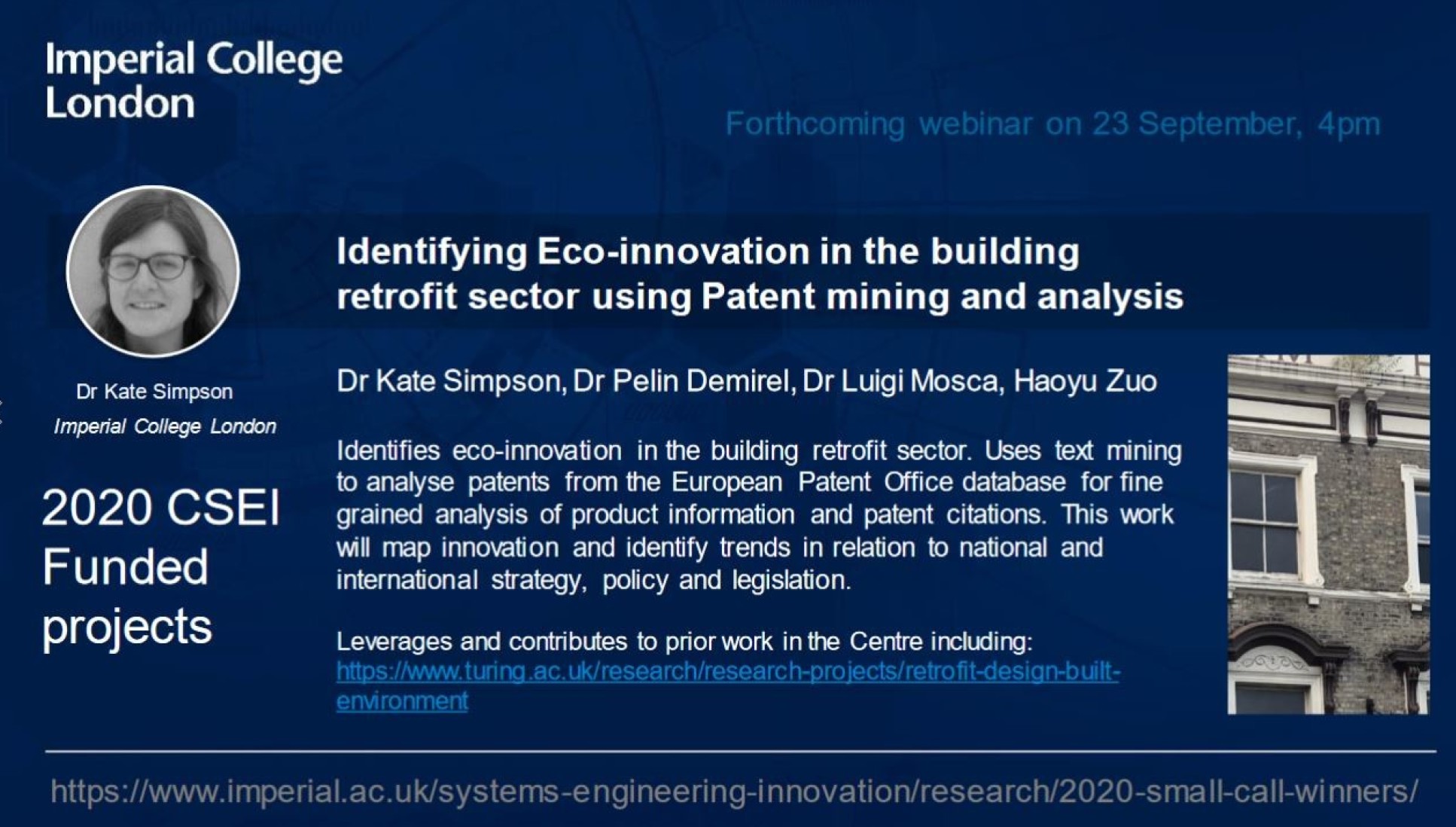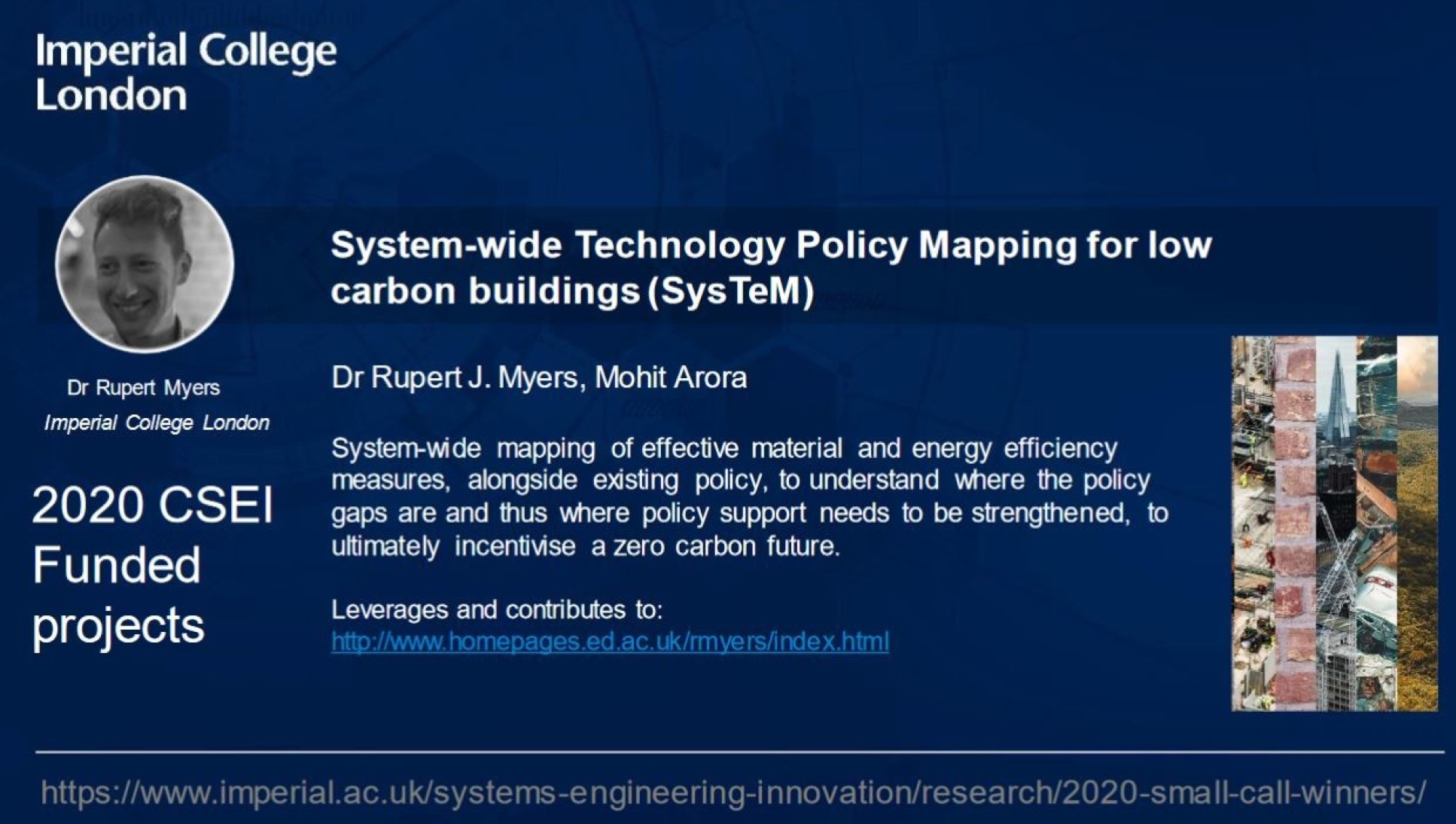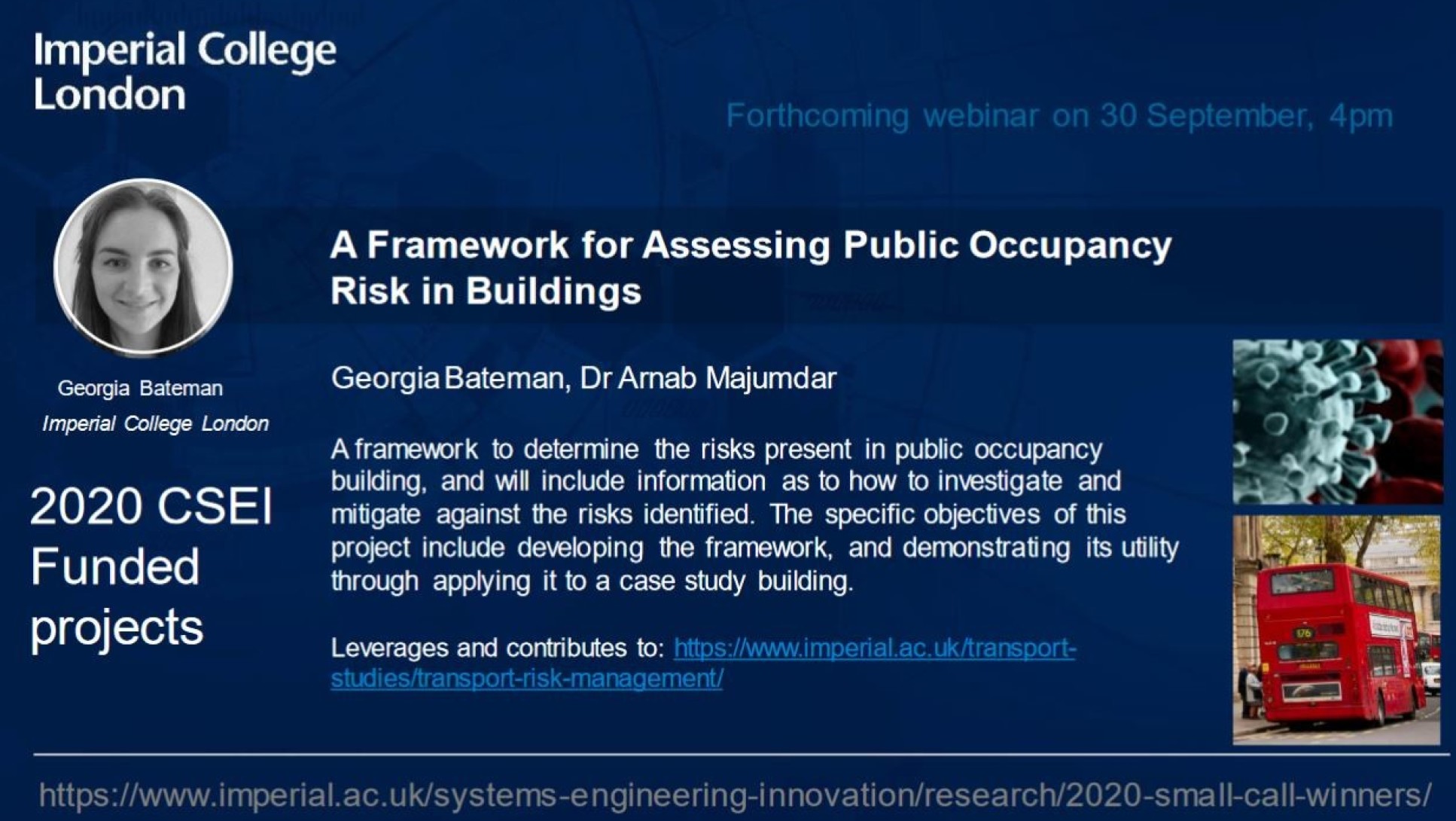2020 small call winners
Centre for Systems Engineering and Innovation – 2020 Research Awards
We are delighted to announce the 2020 awards for small projects from the Centre for Systems Engineering and Innovation, as a result of a recent competition.
Award 1. Identifying Eco-innovation in the building retrofit sector using Patent mining and analysis
 Principal Investigator: Dr Kate Simpson
Principal Investigator: Dr Kate Simpson
Co-Investigators: Dr Pelin Demirel, Dr Luigi Mosca, Haoyu Zuo
The project is designed to support an acceleration of eco-innovation in existing buildings through retrofitting. The project will conduct an analysis of patents on the European Patent Office database using a text mining approach to cluster results. Results will then be compiled into a technology-efficiency map. This research will form the basis for improving routes to market for new innovations and provide firms with a means of improving their ability to identify and shortlist new technology to support their eco-innovation agenda.
The building sector accounts for 39% of EU CO2 emissions. As a result, the need to accelerate the diffusion of eco-innovations (i.e. environmental innovation) in existing buildings is an important aspect of delivering against the Clean Growth Strategy of improving energy efficiency. Eco-innovation in retrofitted buildings has the potential to contribute significantly to this strategy, not only through the introduction of technologies to improve building performance and energy efficiency, but in avoiding higher resource consumption associated with demolition and new-build.
The project will help to provide researchers and practitioners with greater awareness of emerging technologies to inform design and planning practices optimising efficiency. This can assist in overcoming challenges in the diffusion of eco-innovations due to the highly fragmented industry structure.
Award 2. System-wide Technology Policy Mapping for low carbon buildings (SysTeM)
 Principal Investigator: Rupert J. Myers
Principal Investigator: Rupert J. Myers
Co-Investigator: Mohit Arora
The project aims to identify policy gaps to achieve the UK’s climate change targets, focussing on contributions from implementing material/energy efficiency measures in the built environment. Policy interventions to advance material and energy efficiency are vital in the transition to a low carbon-built environment. Development of such (evidence-based) policy interventions for the built environment requires a system-wide mapping of effective material and energy efficiency measures, alongside existing policy, to understand where the policy gaps are and thus where policy support needs to be strengthened, to ultimately incentivise a zero carbon future.
The project compliments and leverages a concurrent 3 year MA’s PDRA fellowship to assess environmental impact reductions that can be realised through the substitution of material-component substitutions in multiple Balfour Beatty projects:
Focussing on contributions from implementing material/energy efficiency measures in the built environment.
(1) a project-based perspective for industry(i.e., material/energy efficiency measures to reduce carbon in specific building/infrastructure systems);and (2) a life cycle-based perspective for local/(inter)national governments(i.e., material/energy efficiency measures to reduce carbon in the wider built environment system).
Notably, the CSEI funding will enable us to use results in the former context (through multiple case studies) to study the latter.
Award 3. A Framework for Assessing Public Occupancy Risk in Buildings
 Principal Investigator: Georgia Bateman
Principal Investigator: Georgia Bateman
Co-Investigator(s): Dr Arnab Majumdar
The aim of this project is to create a generalized framework that can be used to determine the risks present to occupants of a building. The framework will be created in a format that it can be applied directly by industry professionals to both existing and proposed buildings. It will be applicable to any public occupancy building, and will include information as to how to investigate and mitigate against the risks identified. The specific objectives of this project include developing the framework, and demonstrating its utility through applying it to a case study building–the Palestra building, one of Transport for London’s (TfL) key sites.
Workshop and Emerging Research Themes
All of these projects were involved in an online workshop to shape the proposals to Centre interests, six overarching research themes.
- Early stage set-up of projects from a systems engineering perspective
- Infrastructure systems resilience, safety and/or robustness
- Mapping production systems
- Infrastructure as involving cyber-physical systems
- Interconnections between operations and design, e.g. impact of standardisation
- Projects as interventions in infrastructure systems of systems
This workshop, with our industry members, has also helped shape the emerging research areas in that we will celebrate in the 2020 Celebration event.
To support applicants in the refinement of their proposals the Centre runs a Small Calls workshop with attendees from industry to review and discuss the relevance of research ideas from an industry perspective and to ensure that the ultimate impact of the research leads to the potential for real change within an industrial scenario.
This year the Small Calls workshop was run on the 20th April and included participants from Laing O’Rourke, EDF, Bentley Systems, and KBR. Due to Covid-19 lockdown the session was run online and ran very successfully. The workshop began with a presentation from each of the prospective applicants and then groups were split into three breakout sessions where the research concept were explored and discussed in more depth.
The breakout sessions covered three key topics; platform DfMA, low carbon relating to cement technologies and anti-fragility and innovation pathways.
Platform DfMA
The session inspired some interesting discussion around ways in which platform DfMA could be inspired by circuit design. Using the same premise, if repeatable components could be redeployed across multiple systems and then put together on particular projects in the form of a circuit diagram, then how might this help predict performance? There were questions and discussion around how much detail in terms of assemblies or sub-assemblies would be transferred to the diagram and where the lines would be drawn. The discussion continued into a Covid inspired exploration of methods of measuring resilience in manufacturing supply chains and how specific components of delivery could be assessed in terms of their resilience to ensuring the right choices were made in the process of setting up the platform approach.
Low carbon and cement technologies
In this breakout session, the group talked around the subject of low carbon and the development of cement technologies and aggregate solutions that may end up being net negative in the construction space. There was a recognition that applications for new technology and associated research would need to relate to both new build and retrofit markets. The key question identified was, how the right innovative ecosystem could be created to commercialise and encourage new solutions in the space, considering the need for clients to contract for lower carbon solutions, based on lifetime performance as opposed to a simple build cost perspective. The discussion continued around methodologies could be applied for evaluating carbon footprint for infrastructure buildings, and whether there is a systems of systems approach or a simple systems methodology that could be used to support this.
Anti-fragility and innovation pathways
Discussion focused on the connection between the dynamic and static elements of models of anti-fragility in relation to work on human occupancy of buildings and the different risks involved. It was concluded that there is a need for an over-arching framework for all interactions that people have within a building environment from the perspective of public occupancy risk. Is it possible to get some sort of definition for that framework that explores quantitative element? What that might mean? How you would score different risks and evaluate them? Answering these questions would need needs a good understanding of the dynamic and static models and if it could be achieved within the buildings environment space, then it would have implications for other urban scenarios, place-making for example.


